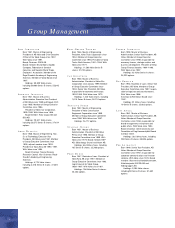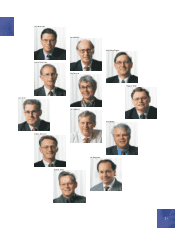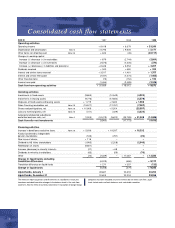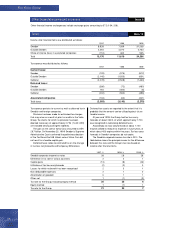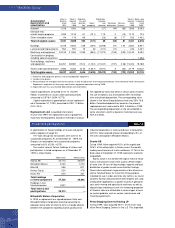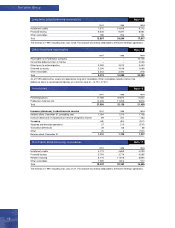Volvo 1999 Annual Report Download - page 61
Download and view the complete annual report
Please find page 61 of the 1999 Volvo annual report below. You can navigate through the pages in the report by either clicking on the pages listed below, or by using the keyword search tool below to find specific information within the annual report.
59
Capital expenditures
Capital expenditures include investments in buildings,
machinery and equipment, as well as in intangible assets.
Investments pertaining to assets under operating leases
are not included.
Investments in fixed assets included in the Group’s
cash flow statement include only capital expenditures that
have reduced the Group’s liquid funds during the year.
Depreciation and amortization of tangible
and intangible non-current assets
Depreciation is based on the historical cost of the
assets, adjusted in appropriate cases by write-downs,
and estimated economic lives. Capitalized type-specific
tools are generally depreciated over 2 to 8 years. The
depreciation period for assets under operating leases is
normally 3 to 5 years. Machinery is generally depreciated
over 5 to 20 years, and buildings over 25 to 50 years,
while the greater part of land improvements are depreci-
ated over 20 years. In connection with its participation in
aircraft engine projects with other companies, Volvo Aero
in certain cases pays an entrance fee. These entrance
fees are capitalized and depreciated over 5 to 10 years.
The difference between depreciation noted above and
depreciation allowable for tax purposes is reported by the
parent company and in the individual Group companies
as accumulated accelerated depreciation, which is in-
cluded in untaxed reserves. Consolidated reporting of
these items is described below under the heading
Deferred taxes, allocations and untaxed reserves.
Goodwill is included in intangible assets and amortiz-
ed on a straight-line basis over 5 to 20 years. The good-
will pertaining to Volvo Construction Equipment, Champion
Road Machinery, The AGES Group, Prévost, Nova BUS,
Mexicana de Autobuses, Volvo Construction Equipment
Korea and Volvo Aero Norge are being amortized over
20 years due to the holdings’ long-term and strategic
importance.
Inventories
Inventories are stated at the lower of cost, in accordance
with the first-in, first-out method (FIFO), or net realizable
value. Provisions are made for obsolescence.
Marketable securities
Marketable securities are stated at the lower of cost or
market value in accordance with the portfolio method.
Liquid funds
Liquid funds include Cash and bank balances and mar-
ketable securities. Marketable securities to some extent
consist of interest bearing securities with maturities
exceeding three months. However, these securities have
high liquidity and can easily be converted to cash.
Postemployment benefits
Most of the Volvo Group’s pension commitments are met
through continuous payments to independent authorities
or bodies that administer the plans. Pension expense
corresponding to the fees paid for these defined contri-
bution pension plans is reported continuously. In certain
of Volvo’s subsidiaries, mainly in Sweden and the U.S.,
there are defined benefit plans covering pensions and
healthcare benefits. For these plans, a provision and
annual pension expense are calculated based on the
current value of the earned future benefits. Provisions for
pensions and annual expenses related to defined pen-
sion and healthcare benefits are reported in Volvo’s con-
solidated balance sheet and income statement by apply-
ing the local rules and directives in each country.
Net sales
The Group’s reported net sales pertain mainly to revenues
from sales of goods and services. Net sales are reduced
by the value of discounts granted and by returns.
Income from the sale of goods is recognized when the
goods are delivered to the customers. Income from the
sale of workshop services is recognized when the service
is provided. Rental revenues and interest income in con-
junction with financial leasing or installment contracts is
recognized over the contract period.
Research and development expenses
and warranty expenses
Research and development expenses are charged to
income as incurred.
Estimated costs for product warranties are charged to
cost of sales when the products are sold.
Items affecting comparability
Items affecting comparability are reported separately in
the income statement. They pertain to considerable
restructuring costs and considerable gains and losses
mainly attributable to changes in the composition of the
Group.
Deferred taxes, allocations and untaxed reserves
Tax legislation in Sweden and other countries sometimes
contains rules other than those identified with generally
accepted accounting principles, and which pertain to the
timing of taxation and measurement of certain commercial
transactions. Deferred taxes are provided for on differ-
ences which arise between the taxable value and reported
value of assets and liabilities (temporary differences) as
well as on tax loss carryforwards. However, with regards to
the valuation of deferred tax assets (the value of future tax
deductions), these items are recognized provided that it is
probable that the amounts can be utilized in connection
with future taxable income.
Tax laws in Sweden and certain other countries allow
companies to defer payment of taxes through allocations
to untaxed reserves. These items are treated as temporary
differences in the consolidated balance sheet, that is, a
division is made between deferred tax liability and equity
capital (restricted reserves). In the consolidated income
statement an allocation to, or withdrawal from, untaxed
reserves is divided between deferred taxes and net in-
come for the year.
Application of estimated values
In preparing the year-end financial statements in accord-
ance with generally accepted accounting principles,
company management makes certain estimates and
assumptions which affect the value of assets and liabil-
ities as well as contingent liabilities at the balance sheet
date. Reported amounts for income and expenses in the
reporting period are also affected. The actual results may
differ from these estimates.





